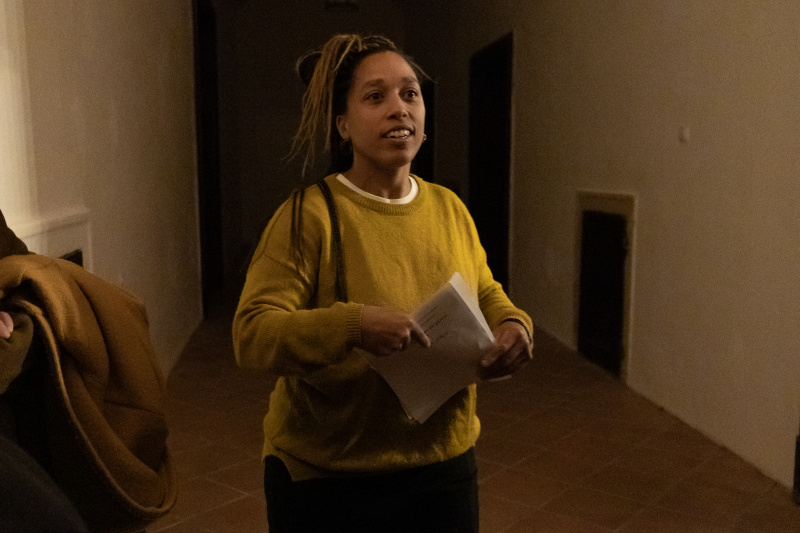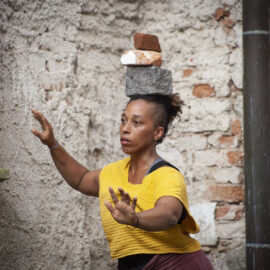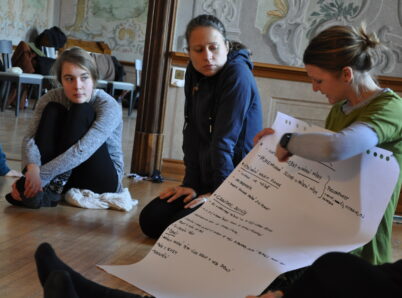
Stéphanie Nyota N'Duhirahe: Admirable approach to the impact of political events on a personal history
SE.S.TA Centre for Choreographic Development hosted circus artists Stéphanie Nyota N'Duhirahe and Morgane Widmer as part of the ART CLUSTERS residency in Žďár nad Sázavou. Both artists come from Switzerland, but have been a solid part of the Prague circus community, based in Kulturní dům Mlejn, since 2010. Each arrived at the residency with her own project: Stéphanie with her experimental collage Šrámy/Děti z bakelitu (Children of Bakelite), in which she reflects on the experiences of people who were children during the Velvet Revolution, and Morgane with her project Carcasse, which explores the social – and environmental – impact of women’s clothing. For these projects, they switched roles, a considerate ecological practice within their platform Cie Pieds Perchés. Unfortunately, I didn’t manage to catch Morgane for the interview, so let’s dive into the interview with Stéphanie.
Do the works Šrámy/Děti z bakelitu and Carcasse have any connection?
The only link is that both pieces are produced by Cie Pieds Perchés. Carcasse is my artistic partner Morgane’s solo, for which I serve as an outside eye. Last year we worked on my solo Šrámy/La débattue – which ended up not being a solo at all. Three of us were on stage: performer Nguyễn Mỹ Ngân, musician Roman Džačar and me. Morgane and Markéta Stránská acted as our outside eyes for the acrobatic sections.
What prompted you to develop Šrámy further?
Šrámy is like a tree. In Šrámy/La débattue I explored my family history and the marks historical events can leave on a family:
What is remembering?
What do we – and our bodies – retain from different life stories?
How is pain passed from generation to generation?
How can we talk about that pain?
The piece tells my story and my father’s. He was ten when the Democratic Republic of Congo – then his country – began decolonisation. I wondered how he perceived that reality at ten, how it shaped him and, by extension, me. A Czech friend of mine, born in 1980, was also almost ten during the events of 17 November 1989. Because I now live in the Czech Republic with my Czech partner, I became curious about how the transition from communism to democracy after ’89 affected both my generation and my father’s. Šrámy/Děti z bakelitu is another branch of that tree.
How can our readers imagine Šrámy/Děti z bakelitu?
Děti z bakelitu is an experimental collage. It weaves sound and video installation with short movement and acrobatic sequences, all supported by live music. Thanks to the residency in Žďár nad Sázavou I could deepen the research by talking with others – asking whether and how this pain has been processed, and how people recall life before and after the regime change.
Your comparative study focuses on people born between 1976 and 1983, so about ten during the Velvet Revolution. How do you work with their testimonies?
I wanted to know what children aged roughly ten to twelve remember. Rather than ask directly „What was 1989 like for you?“, I looked for perception, emotion, space, sound. I’m creating the piece with Markéta Stránská – herself a „child of bakelite“ and the dramaturge. First I drew on my team’s experiences: Eva Lédlová is a bit younger; Maary (Nguyễn Mỹ Ngân) was born in the Czech Republic to Vietnamese parents; and I’ve worked with Roman Džačar for years. We soon felt we needed more voices, more colours of experience.
By chance I found a ten-year-old’s diary that captured everyday life – sometimes just „Came home from school, rode my bike, went to bed.“ It was still an invaluable personal document.
Then we shaped the interview questions. It’s hard – even for me – to remember exactly what I did at ten. We tried to open space in people’s minds with questions such as:
Do you remember what you liked to eat at ten?
Where did you play?
Have you been back?
If so, what has changed?
Reading about Šrámy/Děti z bakelitu sent me back to my own memories. Thank you.
Then you surely recall those tights with shoulder straps and the crotch at your knees – laughter. That level of personal history fascinates me. Collecting many memories lets us share our private stories and build a richer picture of history.
I saw Šrámy/La débattue at the Korespondance Festival and found it powerful. Does the piece work with your personal history?
Yes – creating it has been healing. First I had to recognise that I carry generational trauma. Speaking about it helped me understand why I act or think in certain ways. Knowing where anxiety comes from can make change easier. I looked for an intimate way to share our family story, yet speaking it aloud made me vulnerable. Expanding the show to a trio let audiences experience it on several levels; responses differ according to skin colour, age, gender and so on.
What reactions have you had from family, friends or spectators?
My family haven’t seen the piece yet – they should come in February 2024. Performing in front of my dad will be quite a challenge: „My father told me that…“ – laughs. But I’m looking forward to it; they’re part of the process. We worked together in Žďár: I recorded my dad speaking, his phrasing, the sounds he makes. My sister Cécile Nduhirahe also joined – many objects on stage come from her drawings.
From broader audiences I’ve heard that they understand and relate in their own way, which is exactly what I hoped. I didn’t want to deliver a didactic message about decolonisation.
With Šrámy/Děti z bakelitu we want to share the recent history of the Velvet Revolution, but it still feels close, almost raw.
Do you think thirty years is a short time?
Yes – far too close. Imagine needing fifty years before we can talk freely. Without taking that step my father might never speak about those atrocities. We’re the second generation after decolonisation and we can feel the impact of his storytelling.
When will Šrámy/Děti z bakelitu premiere?
It premieres on 17 and 18 April 2024 at Studio Prám in Prague-Vysočany. If you’d like a taste, watch the videos.
Good luck!


